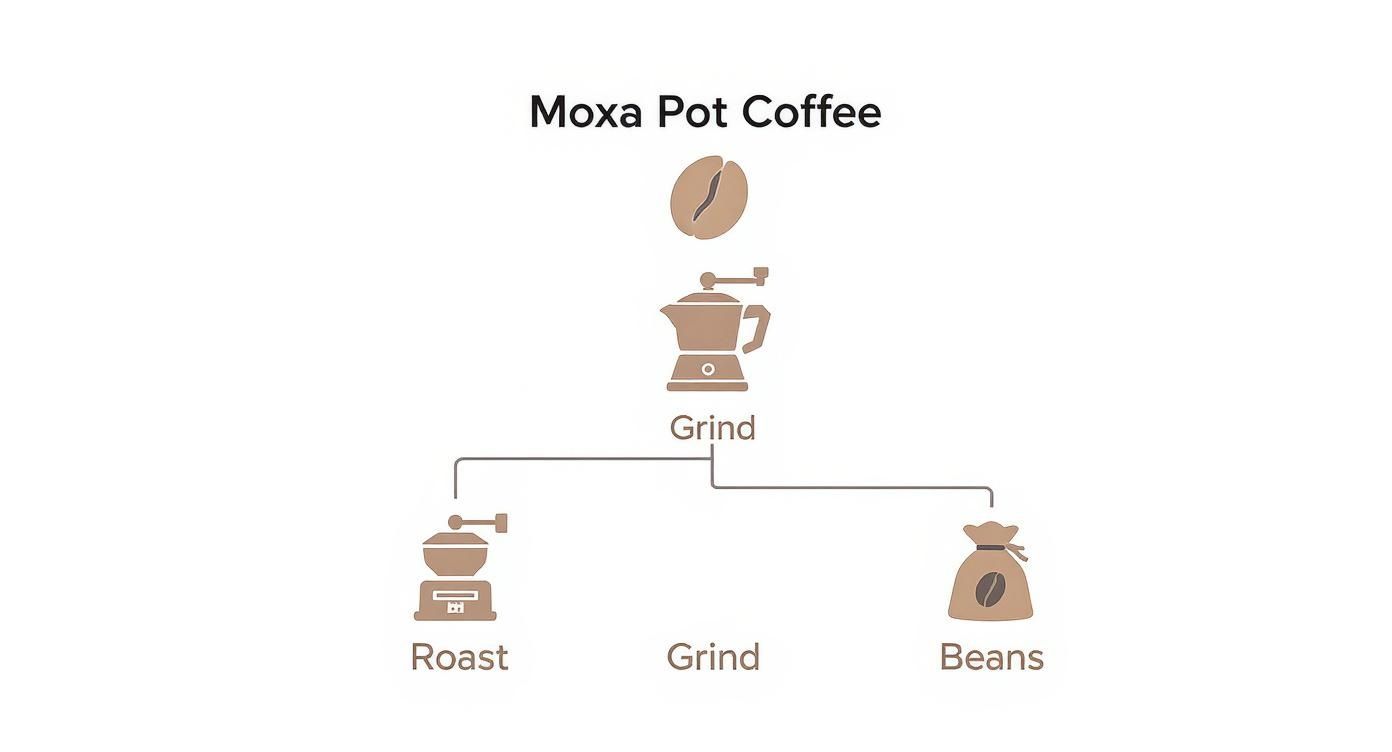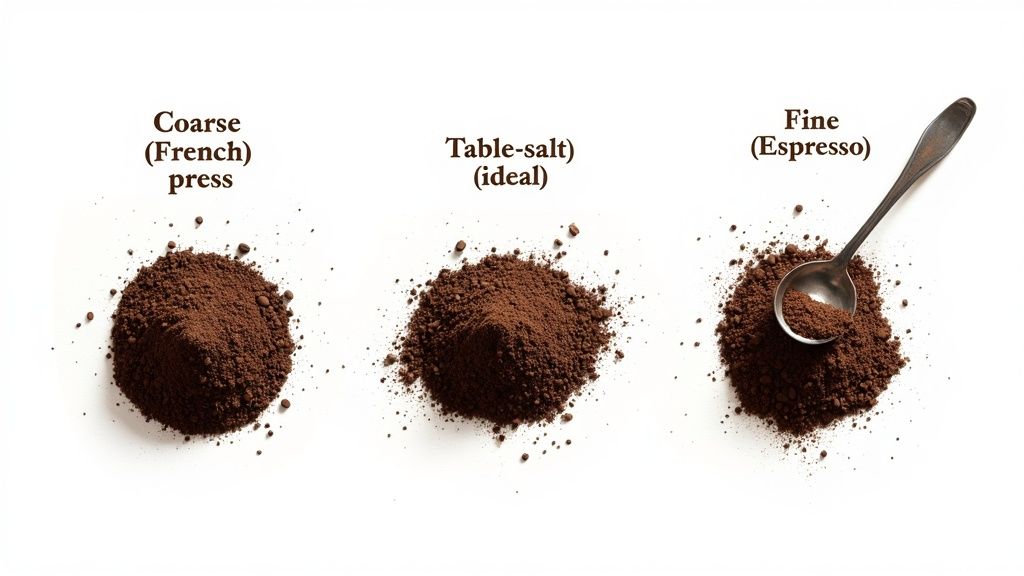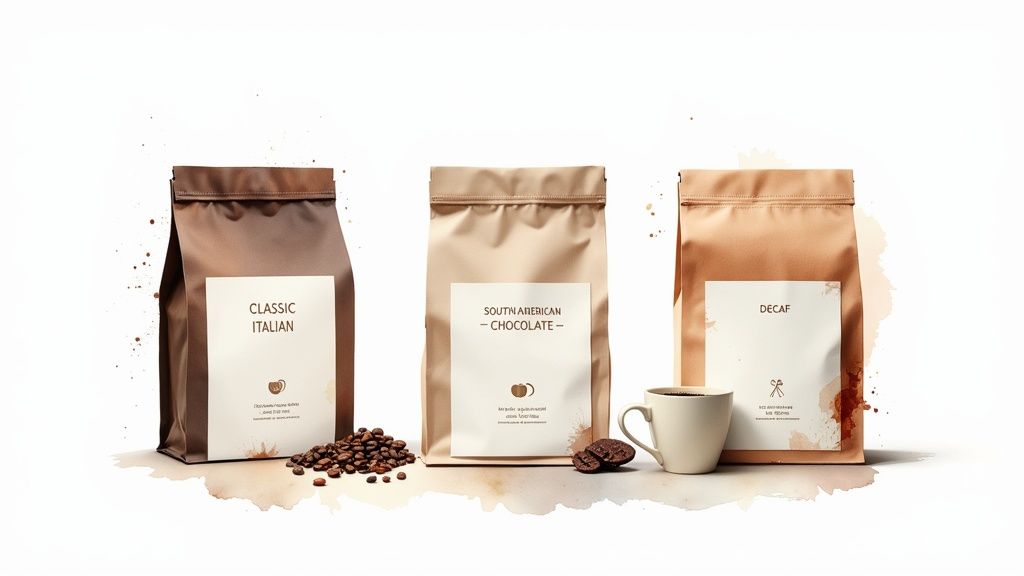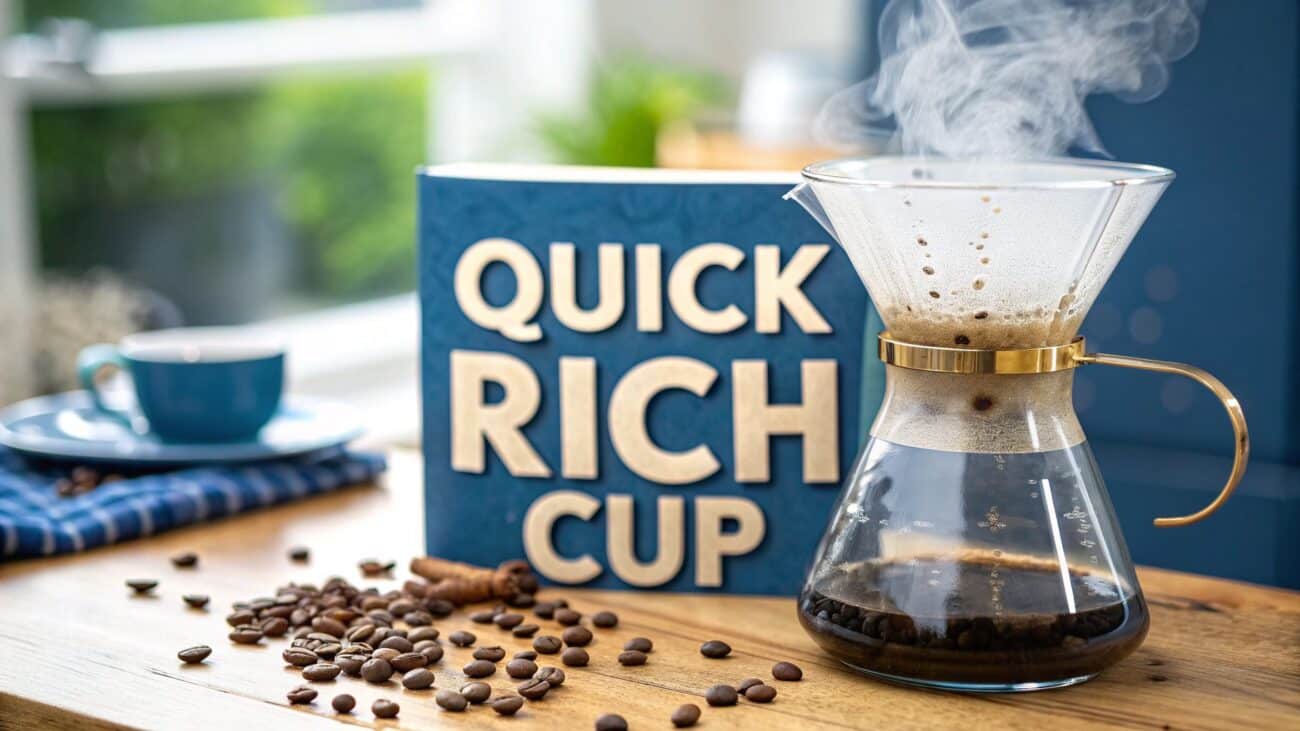Best coffee for moka pot: Find Your Ideal Brew

The secret to a brilliant moka pot brew is using a medium to medium-dark roast ground to the consistency of table salt. Think finer than you'd use for a drip machine, but just a little coarser than a true espresso grind. Get this combo right, and you're on your way to a rich, intense, and wonderfully smooth cup.
Your Guide to Perfect Moka Pot Coffee
It helps to think of your moka pot as a tiny, stovetop pressure steamer. It uses a gentle build-up of steam to push hot water through the coffee grounds, which means every little detail—from the roast to the grind—massively impacts the final taste. Nailing the basics is what separates a bitter, burnt disaster from a truly rewarding brew.
And it seems we're all getting more serious about our home coffee game. In the UK, we're now drinking around 98 million cups a day, a clear sign that more and more of us want that café-quality experience without leaving the house. The moka pot fits this trend perfectly, delivering an espresso-like kick without the eye-watering price tag of a high-end machine.
To make things even easier, here's a quick decision tree to help you pick the right roast, grind, and beans every time.
As the infographic shows, your journey starts with the roast level, then moves on to the grind and bean origin. Understanding these fundamentals is the key to unlocking your moka pot’s potential. If you want to dive a bit deeper into the whole process, our guide on how to make coffee with beans is a great place to start. For now, let’s break down each of these factors one by one.
Quick Guide to Moka Pot Coffee Selection
For those in a hurry, this table summarises the ideal coffee characteristics for your moka pot. It’s a handy cheat sheet to keep in mind next time you're buying beans.
| Characteristic | Ideal Choice | Why It Matters |
|---|---|---|
| Roast Level | Medium to Medium-Dark | Balances rich flavour with sweetness, avoiding the sourness of light roasts. |
| Grind Size | Fine (like table salt) | Ensures proper water flow and extraction without clogging the filter or tasting weak. |
| Bean Type | 100% Arabica | Offers smoother, less bitter flavours that suit the moka pot's intense brew style. |
| Origin Profile | Latin American or Indonesian | Provides classic notes of chocolate, nuts, and caramel that shine in a strong brew. |
| Freshness | Freshly Ground | Maximises aroma and flavour, as pre-ground coffee loses its character quickly. |
Getting these elements right will consistently give you a brew that is bold and full-bodied, yet smooth enough to enjoy every single day.
Why Roast Level Is Your Most Important Choice
Of all the choices you'll make when picking beans for your moka pot, getting the roast level right is, without a doubt, the most important one. Think of it like toasting bread; a light touch leaves it doughy and underdeveloped, while too much heat turns it into a charred, bitter mess. Coffee roasting is surprisingly similar, completely transforming the bean’s character from one minute to the next.
The moka pot’s intense heat and super-quick brew time mean it's quite fussy about the kind of roast it works well with. Get it wrong, and you'll know about it.
Finding the Moka Pot Sweet Spot
Light roasts, for example, almost always taste sour or "green" in a moka pot. Their delicate, acidic notes need a much longer, gentler extraction to properly develop—something the speedy moka pot just can't deliver. The result is often a sharp, underwhelming cup that completely misses the mark.
On the other end of the scale, very dark, oily roasts can cause chaos. Those excess oils can easily clog the filter screen, which leads to a dangerous build-up of pressure and, ultimately, a burnt, horribly bitter brew. The high heat of the moka pot amplifies any harsh, acrid flavours, totally overpowering the coffee’s natural sweetness.
The perfect balance for a moka pot is a medium to medium-dark roast. This roast level develops those rich, classic notes of caramel, chocolate, and toasted nuts without introducing the sharp sourness of a light roast or the overpowering bitterness of a dark one.
This "sweet spot" gives you a coffee that’s robust enough to stand up to the moka pot’s brewing style, creating that full-bodied, deeply satisfying cup it’s famous for. This is how you unlock that iconic, smooth, and rich flavour profile. If you're keen to dive deeper into how heat shapes these flavours, our guide on coffee roasting profiles explained is a great place to start.
Choosing a medium to medium-dark roast gives you:
- Rich Flavour: Deep notes of chocolate and caramel really come to the forefront.
- Balanced Acidity: The harshness of a light roast is smoothed out into a pleasant sweetness.
- Optimal Extraction: The beans are developed just enough to release their full flavour in the short brew time.
Ultimately, this roast level is perfectly suited to the moka pot’s unique demands, consistently delivering that strong yet smooth coffee experience we all chase.
Nailing the Perfect Moka Pot Grind Size
If choosing the right roast is the first big decision, getting the grind size right is where most home brewers trip up. A truly flawless moka pot brew lives or dies by the consistency of your coffee grounds. To get your head around why, just picture pouring water through a jar of pebbles versus a jar of fine sand.
The water will rush straight through the pebbles, but it’ll get completely stuck in the sand. An espresso-fine grind is just like that sand—it's so dense that it literally chokes the moka pot. This compaction stops water from passing through, which can create a dangerous build-up of pressure and always results in a bitter, over-extracted coffee.
Go the other way with a coarse, French press-style grind, and you've got the pebble problem. Water flows through far too quickly, barely interacting with the coffee. The result? A weak, watery, and deeply unsatisfying cup.
Finding the Perfect Balance
So, what are we aiming for? Your target grind size should feel a lot like table salt. It’s fine enough for the hot water to pull out all those rich, complex flavours but coarse enough to let it pass through evenly without turning into a blockage. This balance is absolutely non-negotiable for getting the best coffee out of your moka pot.
The ideal moka pot grind is a medium-fine consistency. It should feel slightly gritty between your fingers, not powdery like an espresso grind or chunky like something you'd use for a French press.
Hitting this middle ground ensures you extract the full depth of flavour from your beans without any of the harshness. If you’re new to grinding your own beans, our comprehensive coffee grind size guide offers a great visual breakdown to help you nail it every single time.
With the UK's branded coffee shop market now pulling in an impressive £6.1 billion in revenue, it's clear we have a massive appetite for richer coffee experiences at home. The moka pot delivers this perfectly, but only when you get the details right. Getting your grind spot-on is the first real step towards brewing that professional-quality cup in your own kitchen.
Choosing Beans with the Right Flavour Profile
Where your coffee comes from has a massive say in how it tastes. Think of it like wine – the soil, the climate, and even the altitude all leave their mark on the final flavour in your cup. When you're brewing with a moka pot, the game is all about finding beans that give you a rich, smooth, and low-acidity brew, because its intense brewing style can really dial up any sharpness.
Classic choices from Central and South America are absolutely fantastic starting points. Beans from places like Brazil, Colombia, and Guatemala are famous for those comforting and familiar notes of chocolate, nuts, and caramel. These are the exact flavours that a moka pot loves to amplify, creating a brew that’s big and bold, but beautifully balanced.
On the other hand, you have high-acidity African coffees. While they can be delicious, their bright, citrusy notes can sometimes turn sharp or even sour under the moka pot’s pressure. That doesn’t mean you should write them off completely, but they definitely need a more careful hand to get right.
Navigating Coffee Origins
To get the best results straight out of the gate, start with origins known for producing that classic, full-bodied cup. This is your flavour roadmap.
- Brazil: Often the backbone of traditional Italian espresso blends, Brazilian beans are famous for their low acidity, heavy body, and sweet, nutty flavours. They’re a near-perfect match for the moka pot.
- Colombia: These beans typically strike a wonderful balance between caramel sweetness and a mellow, citrus-like acidity. They produce a rich, satisfying cup that is consistently smooth.
- Guatemala: Look for Guatemalan beans from lower altitudes. These tend to have a fuller body with distinct chocolate and toffee notes, making them ideal for a strong, satisfying brew.
The best coffee for a moka pot often comes from a single origin where the natural flavour profile is already rich and low in acidity. This creates a brew that is bold and intense without being harsh or bitter.
Diving into beans from different regions is a fantastic way to discover what you really enjoy. Our collection of single-origin coffee beans is a great place to begin your journey, offering a curated selection of flavours perfect for experimenting with. Ultimately, it’s about moving beyond generic blends and starting to choose beans with confidence, matching them perfectly to your taste and your moka pot.
Our Top Coffee Recommendations for Your Moka Pot
Alright, we’ve covered the theory—the why and how of moka pot brewing. Now it's time for the fun part: picking the actual coffee. This is where you get to connect all those ideas about roast, grind, and origin to the beans you'll be enjoying every morning. Instead of just listing brands, I'll walk you through a few key flavour profiles. Think of this as a guide to finding your perfect match, whether you're clicking "add to basket" online or chatting with your local roaster.
The moka pot is a brilliant daily driver, especially if you need a proper kickstart to your day. In fact, a survey of 20,000 UK workers found that journalists and media pros are the biggest coffee drinkers, knocking back an average of 3.62 cups per day. That rich, espresso-like brew a moka pot delivers is tailor-made for anyone needing a regular, potent caffeine hit.
For the Traditionalist: Classic Italian Blends
If what you’re after is that timeless, punchy flavour that instantly transports you to a bustling Italian café, then you need to look for blends made specifically for stovetop brewing. These are usually a classic mix of Arabica and Robusta beans, taken to a medium-dark roast to create a rich, full-bodied coffee with almost no acidity and a gorgeous, thick crema that lingers on top.
You can expect bold notes of dark chocolate, toasted nuts, and just a hint of smokiness. This profile is the very definition of authentic moka pot coffee. Funnily enough, these are the same kinds of beans you’d want for a classic espresso. If that piques your interest, you can dive deeper in our guide on the best beans for espresso coffee.
For the Chocolate Lover: South American Single Origins
Maybe you prefer a smoother, sweeter cup? If so, single-origin beans from places like Brazil or Colombia are a fantastic shout. These coffees are famous for their mellow acidity and comforting flavours, typically dominated by notes of milk chocolate, caramel, and nutty undertones.
When you brew these beans in a moka pot, those comforting notes become incredibly rich and almost decadent. A medium roast is perfect here, as it preserves the beans' natural sweetness while developing enough body for a truly satisfying and well-rounded cup.
For the Decaf Drinker: Flavourful Options Without the Buzz
Going caffeine-free doesn't mean you have to put up with bland coffee. Not anymore. The key is to look for decaf beans processed using the Swiss Water method, a clever technique that gently removes the caffeine without relying on harsh chemicals. A medium-dark roasted Colombian or Brazilian decaf will hold onto its wonderful chocolatey and nutty character, giving you a rich and satisfying brew that tastes like the real deal.
Your Moka Pot Coffee Questions Answered
Even when you think you've found the perfect beans, a few little questions always seem to pop up on the journey to mastering the moka pot. Let’s tackle some of the most common ones and get you brewing like a pro.
Can I Use Espresso Coffee in a Moka Pot?
While it’s tempting to grab that bag labelled ‘espresso’, it’s usually not the best idea. Most pre-ground espresso coffee is far too fine for a moka pot.
That powder-like consistency can easily compact and clog the filter basket. This creates way too much pressure inside the pot, leading to a horribly bitter and over-extracted brew. For a much happier moka pot, stick to a grind that looks and feels a bit like table salt.
Why Does My Moka Pot Coffee Taste Burnt?
A burnt or bitter flavour is almost always a sign of one of three things: your grind is too fine, your roast is too dark and oily, or you’re leaving the pot on the heat for too long.
To fix this, try a slightly coarser grind and maybe switch to a solid medium-dark roast instead of an ultra-dark one. The most important trick, though, is to take the pot off the heat the very moment it starts to gurgle. This simple move stops the coffee from scorching right at the end of the brew.
Is Moka Pot Coffee the Same as Espresso?
Nope, and it's a common misconception. Moka pots brew coffee at a much lower pressure, somewhere around 1-2 bars. A proper espresso machine, on the other hand, forces water through the coffee at a powerful 9 bars.
The result is something uniquely its own: a rich, concentrated coffee that’s much stronger than your average drip brew but doesn't have the thick crema or syrupy body of a true espresso. Think of it as its own delicious category—stovetop espresso, bold and satisfying in its own right.
Ready to find the perfect beans for your next brew? Explore the hand-roasted, ethically sourced selection at Seven Sisters Coffee Co and discover your new favourite today. Find your ideal coffee at https://sevensisterscoffee.co.uk.








